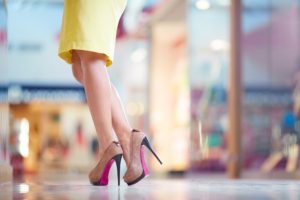A few weeks ago I traded in my sneakers for heels to attend an all day event.
Because I am 5’3 it is a must (in my opinion) for me to wear heels when I dress
up. Fortunately, my profession doesn’t require me to wear them on a daily basis.
When I wear high heels it usually just for a few hours going out to dinner on a
Saturday night.
This recent event lasted 8 hours. I could barely stand on my feet when I took my
shoes off that evening. My feet were swollen and throbbing. My knees and back
even hurt. (Good thing I know a good physical therapist!) I wasn’t even walking
in my heels though. I was just standing there. Standing in a position that my
body apparently did not like. Why is that though? Why do heels give us so much
grief?
High heels put stress on the feet, ankles, knees, and back due to poor posture
and body weight redistribution. The higher the heel . . .the worse the strain.
So, just standing in my high heeled shoes pushed my body weight forward,
taking my hips and spine out of alignment (or it’s best position). This posture
also places increased force on the inside of the knee (one of the most common
sites of arthritis).
As I stood there longer, heel cord and calf muscle shortened resulting in heel pain.
The increased pressure this put on the front of my foot resulted in pain at the ball
of my foot.
Since high heels are not currently a habit for me, I did recover in a few days.
However, there are long term conditions that result from consistently wearing
high heeled shoes:
- Morton’s Neuroma – thickening of tissue between the 3rd and 4th toes
impinging a nerve which cause toe pain and numbness.
- Bunions – painful bony growth at the base of the big toe
- Hammertoes – smaller toes are pushed into a bent positioning resulting
in corns at the middle joint of the toe.
- Metatarsalgia – foot joint pain from increased pressure
- Haglund’s Deformity – a bony enlargement and irritation at the back of
the heel sometimes called “pump bump”
- Plantar fasciitis – inflammation of the tissue at the bottom of the foot
If you already have foot pain or back problems, its best that you avoid high heels
all together. At least until the problem gets better or preferably goes away.
If you don’t currently have any concerns, here are some considerations
when buying shoes and ways the minimize the negative effects high heel
shoes have on your body:
1. Choose shoes with good padding or add padding to the ball of the foot
2. Buy shoes at the end of the day so the size accommodates foot swelling
3. Look for a gradual slope to more evenly distribute body weight
4. Find rubber soled shoes for better absorption of pressure
5. Choose a chunky or wedge heel for a wider base of stability
6. Buy shoes with heel of 2 inches or less
Just like anything else in life, the best way to wear high heel shoes is in moderation.
Try to decrease the amount of time you stand and walk in them. For example, change
out of your heels (for flats or sneakers) at the office before walking to your car.
For more information on stretches or exercise to relieve foot pain, fill out our online
Inquiry Form and we can get you the information you need!




